Douglas, County Cork
| Douglas Dúglas | |
|---|---|
| Populated place | |
.jpg) Douglas at the turn of the 20th century, with a Cork Electric Tramways and Lighting Company tram | |
 Douglas Location in Ireland | |
| Coordinates: 51°52′35″N 8°26′9″W / 51.87639°N 8.43583°W | |
| Country | Ireland |
| Province | Munster |
| County | Cork |
| Population (2011) | |
| • Total | 25,655 |
| Time zone | UTC+0 (WET) |
| • Summer (DST) | UTC-1 (IST (WEST)) |
| Website |
douglascommunity |
Douglas (Irish: Dúglas or Dúbhglas, meaning "dark stream") is a suburb of Cork city, Ireland and the name given to the Roman Catholic, Church of Ireland and Civil parish in which it is contained. As its borders are ill-defined and it straddles the boundary between Cork city and County Cork, it is difficult to ascertain the exact population. The CSO gives a figure of 19,787 for the parts of Douglas that lie within Cork County.[1] No figure is provided for the parts within Cork City, although the combined population of the Tramore A, Tramore B, Tramore C and Browningstown electoral divisions, which lie in Douglas, is 5,868.[2] This suggests a total population of approximately 25,655. The 2017 Mackinnon Report proposed that Douglas and surrounding residential areas be moved to within an extended Cork city boundary, potentially ending the division of Douglas between the city and county administrative areas.[3] This was approved by the Cabinet on June 6th 2018, with Douglas and surrounding areas Rochestown, Grange and Frankfield to move into the city council area following the 2019 local elections.[4][5]
History
Prehistory
There are a number of extant or proposed prehistoric sites in Douglas and the surrounding area, including a shell midden, ringforts, souterrains, and a fulacht fiadh.[6][7] Further evidence of prehistoric settlement in the area includes the finding of a Bronze Age decorated beaten gold disc in the townland of Castletreasure; although reputed to be related to the ruined castle of the same name, it has actually been dated to 2500-2000 BC.[8][9][10]
Origins (13th-17th century)
Douglas was first mentioned in an inquisition on the lands of Gerald de Prendergast in 1251, and in a 1291 taxation document which records the lands as being an appurtenance of the Church of Bauvier.[11] It is alternately listed as "Duffelglasse" and "Duglasse" in 1302 and 1306, respectively, as part of the parish of Carrigaline. In the year 1603, it became one of the liberties of Cork City.[12] In 1615, parochial records mention the chapel of Douglas being laid waste, reportedly due to theft of the foundation stones, and in a 1700 entry of the same records it is mentioned that the ruined chapel in question had been the church of the Carrigaline parish for a century prior to the construction of a new church in Carrigaline.[12][13] By the mid-seventeenth century, it had a population of 308 people (of whom 33 were English) and consisted of a number of large farms.[14]
Linen industry (18th-19th century)
The area began to develop as an urban settlement in the early eighteenth century with the opening of the "Douglas factory" in 1726, reported in August 1755 to be the property of "Messrs. Perry, Carleton and Co.", with 100 looms initially operational.[12][14][15] The mills produced sail-cloth and supplied sails to the Royal Navy, amongst other clients. The industry was established by Huguenot weavers and textile workers, such as the Besnards, who acquired the Mills by 1783 and in 1801 installed the first powered spindles in Ireland, along with skilled workers from Ulster and Scotland.[14][15][16] In addition to the mill workers, employees included over 1,000 spinners working from their houses, and hacklers, bleachers and labourers tasked with preparing raw material in Douglas village.[16]
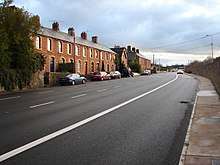
Further textile mills opened in the nineteenth century, including an additional Besnard-owned scutching mill (Ravensdale, 1806),[16][17] Lane’s Corn and Hemp Mills (now Douglas Community Park, 1845),[14][18] O’Brien’s Brothers (St Patrick’s Woollen Mills, 1882),[14][19] Donnybrook Mills (Wallis & Pollock Flax Mills, 1866; re-opened as Morroghs' Woolen Mills, 1889/1890)[14][20] and Conroy’s Rope and Twine Mills (now Galway's Lane, 1892).[18][14] Most of the mills ceased to operate in the early twentieth century, although St. Patrick's Woollen Mills and Donnybrook Mills continued to operate until the 1970s.[14][15] Some of the houses built for the mill workers are still in existence, including a terrace of houses near the junction of the Grange Road and Donnybrook Hill.[21]
Other large businesses of the time included an Osiery beside Conroy's Mills, two large brick manufacturers which straddled the nearby estuary, the Ravensdale Flour Mill, and the Woodville Flour Mill which was situated south of the Rochestown train station and produced sea biscuits and ship bread.[22]
Douglas developed as a suburban area throughout the later eighteenth century and the nineteenth century, and was noted for the high concentration of 'big houses'. The popularity of the area among the nobility was such that elevated prices were commanded for the surrounding lands, and as a result, the acreage of the estates was lower than average.[23] The oldest house was believed to have been Ronayne's Court, built in 1627 by Morris Ronayne; although the house was demolished in 1969, the original inscribed fireplace was moved to Blackrock Castle.[24][25] The nearby Montfieldstown House was reputed to be the inspiration for Havisham House of Dickens' Great Expectations, having been abandoned following a ruined wedding.[24] Bloomfield House was connected to a notorious libel case between the prominent Cork Pike and Beamish families, in which the judge, who ruled in favour of Pike in Pike v Beamish, was given the house upon announcement of the verdict by the mother of the plaintiff.[26][27] Windsor House was occupied by Lord Bandon, Sir Abraham Sutton and the Kiltegan Fathers, before being redeveloped as the Rochestown Park Hotel.[27] Ballybrack House was occupied by the Lane family, also of Vernon Mount, and is the birthplace of art dealer Sir Hugh Lane. It received frequent visits from Lady Gregory, a close relation of the family.[27] High Court, built in 1720 and later known as Westgrove, was the birthplace of playwright and Abbey director Lennox Robinson.[27] Grange House was home of the Conron family, descended from Sir Christopher Hatton, for over 300 years.[28] Douglas Hall, one of the few remaining examples of a slate-fronted house in Ireland,[29] was home to Rev. Dr. Francis Moylan, Bishop of Cork, who was made a freeman for his rhetorical opposition to the French invasion at Bantry Bay during the 1798 Rebellion.[28] Vernon Mount, which had one of the earliest examples of a domestic central-heating system installed in any house in Ireland, was occupied by Sir Henry Browne Hayes, who was sentenced to penal servitude in Botany Bay after attempting to abduct an heiress for forced marriage, where he built the Gothic Revival Vaucluse House.[30][31] Other prominent Big Houses included Ravenscourt House, Old Court, Norwood Court, Ballybrack House, Donnybrook House, Montpelier House, Grange Erin, Castletreasure House, Bellvue House, Tramore House (home of the philanthropic Reeves family[32]), and Maryborough House (now the Maryborough House Hotel, with an earlier late-17th century lodge).[33]
Douglas was made a separate Roman Catholic parish sometime before 1768. St. Columba’s (Roman Catholic) church was built in 1814 by the Rev. Thomas Barry, according to local legend using the stones of the ruined castle of Castletreasure.[34][35] A Douglas "Chapel of Ease" to the Church of Ireland parish of Carrigaline was established on the 17th September 1786, with the establishment of a full separate parish in February 1875. In 1855, the Protestant population of the parish was reported as having been 310, with 150 children attending the parish school.[36] The 1785 church was rebuilt and reconsecrated on 27 August 1875 as St. Luke’s church,[35] however, following the death of the resident Canon in 1886, as well as the principal architect, the church remained without a spire until 1889, with the church bell and tower clock donated by Mary Reeves of Tramore House, with the stipulation that the clock face towards her front door.[37][38][39][40] Notable parishioners interred at St. Luke's include the poet Richard Alfred Milliken and librarian Richard Caulfield; in addition, a plaque was erected in the memory of art collector Sir Hugh Lane, deceased in the sinking of the Lusitania.[37][38] The nearby parish of St. Finbar's opened a chapel of ease in Frankfield in 1838, later known as the Holy Trinity, on ground donated by Samuel Lane.[41] An additional graveyard, located on Carr's Hill, was opened in 1848 on land donated by the Master of the Workhouse, George Carr, to deal with the increase in deaths from the Great Famine.[42]
In 1898, the Cork Electric Tramways and Lighting Company built a route from Cork City to Douglas. This operated until 1932 when it was replaced by a bus service.
Later developments (20th-21st century)
In the second half of the twentieth century, Douglas underwent major changes as it became a suburb of Cork. A large amount of new housing was built and the area between Douglas and Cork City became entirely built-up. Schools, shopping centres, cinemas and other amenities developed to serve this new population. Douglas Community School was built in 1968 and the original Douglas Shopping Centre was completed in 1972. This shopping centre underwent a significant redevelopment at the turn of the 21st century. A second shopping centre, Douglas Court Shopping Centre, was built in the late 1980s and a 5-screen multiplex cinema was also built. Several hotels, including the Rochestown Park Hotel and Maryborough House Hotel were also developed. Douglas has two golf courses, Douglas Golf Club at Maryborough Hill and Frankfield Golf Club in Frankfield. The Frankfield course also contains a driving range.
Following the release of the MacKinnon Report in 2017, covering a possible extension of Cork city's boundary, it was proposed that the Douglas area (including Douglas, Frankfield, Grange and Donnybrook) would be moved to the administrative area of Cork City Council.[3] This, if implemented, would move all of Douglas to the city, ending the divide of the town between the city and county.
Residential areas
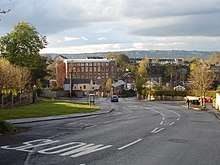
From the late 19th and into the 20th century, there was an expansion of residential areas in the Douglas catchment.[43][44] Housing developments (mostly private, with some social housing) were built in Grange, Frankfield, Donnybrook, Maryborough, Rochestown, Mount Oval and along the two main roads connecting Douglas to Cork city, the Douglas Road and the South Douglas Road.[45]
Donnybrook, for example, is South of Douglas village, and a Centra outlet, snooker club, football club (College Corinthians) and forested walkway (at Ballybrack Woods) serve as amenities for the residential developments in the Donnybrook Hill area.[46]
Grange and Frankfield (encompassed by Frankfield/Grange parish)[44] lie to the West of Douglas village, and are mainly residential areas served by retail outlets (including SuperValu and Aldi), schools (like Scoil Nioclais primary school) and other services (including an office of Douglas credit union).[47] The residential development at Mount Oval has a bar, Spar, and a pharmacy.[48]
Amenities
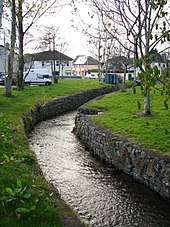
Amenities and green-spaces in the area include Douglas Community Park (a 5-acre park close to the centre of Douglas which includes a playground),[49] and Ballybrack Woods (a wooded area south of Douglas village which is known locally as 'Mangala').[46]
There have been calls to build a pedestrian and cycle trail through the woods around Vernon Mount,[50] carried by an overbridge across the South Ring Road to Tramore Valley Park.[51][52]
Shopping and business
The village centre of Douglas has two principal commercial streets, Douglas East and Douglas West, which are situated approximately 300m apart. However, most retail activity takes place in the two shopping centres, Douglas Village Shopping Centre (anchored by Tesco, Marks and Spencer and TK Maxx) and Douglas Court Shopping Centre (anchored by Dunnes Stores).
Douglas was formerly the site of the headquarters of Cork and Limerick Savings Bank. However, this bank was merged into Trustee Savings Bank in 1992. The former headquarters was initially still used for regional administration, but this function was transferred to a new building in Cork Airport Business Park.
A farmers market is held every Saturday morning and Friday evening by the eastern entrance of the Douglas Village Shopping Centre.
Demographics
In the 2011 census, the percentage of Irish nationals living in Douglas was 88.8%. UK nationals accounted for 1.7%; Polish nationals 3.2%; Lithuanians 0.6%; Other EU nationals 2.1%; Other nationals 2.9%; 0.7% did not state their nationality.[53]
In the 2011 census, 84.7% of Douglas residents identified as Catholic; 7.9% were members of other religions; 6.2% were irreligious; 1.2% did not state a religion.[53]
Sport
GAA
.jpg)
GAA clubs in the area include the Douglas GAA and Nemo Rangers hurling and football clubs. Nemo Rangers were historically associated with Turners Cross, but moved to a new location in the Trabeg area of Douglas in the 1990s.
In the 2004, 2007 and 2012 u10 Community Games, Douglas won the Cork Community Games, the Munster Community Games and the all-Ireland Community Games.
Association football
Local association football (soccer) clubs include Tramore Athletic FC, Grangevale AFC, College Corinthians and Douglas Hall AFC.[54]
Golf
There are also local golf (and pitch and putt) clubs, including Douglas Golf Club,[55] Frankfield Golf Club and Douglas Pitch and Putt Club.
Rugby union
Douglas has representation in rugby union, and Douglas RFC was founded in 1902 as one of the earliest Cork rugby clubs.[56] This club is believed to be an offshoot of the social activities of St Patrick’s Woollen Mills. Early reports are sketchy, although club match reports can be viewed in early newspapers up to 1914. From 1914 onwards there is no mention until 1979 when the club was restarted by two local men, Joe O'Reilly (involved in local politics and sport) and Séamus Corkery (formerly of Cork Constitution).
Other sports
Other sports and clubs include tennis (Douglas Tennis Club), basketball (Fr. Mathews Basketball Club), gymnastics (at Douglas Gymnastics Club), cricket (Cork Harlequins), martial arts (Elite Fitness Centre) and hockey (Cork Harlequins and Church of Ireland Hockey Club, Garryduff).
Transport
Road
The N40 passes through Douglas, but it is not possible to turn onto it in an eastbound direction and westbound traffic may not leave the road. Fuller access is available via the N28 from nearby Rochestown.
Douglas is served by a number of R-standard roads, including the R609 (which links to the N28 at Maryborough), R610 (Passage West to Cork city centre), R851 (Cork city centre to the N27), and R853 (to Ballinlough).
Bus
Bus services are provided by Bus Éireann, and the routes which pass through Douglas include numbers 206 ( Grange to the city centre), 207 (Donnybrook to Ballyvolane), 216 (Mount Oval to Cork University Hospital), 219 (Mahon to Cork Institute of Technology), 220 (Carrigaline to Ballincollig), and 223 (Cork City Centre to Haulbowline).
Rail
The nearest active railway station is Cork Kent railway station, approximately 5 km away. Until 1932, Douglas was served by the Blackpool-Douglas route of the Cork Electric Tramways and Lighting Company.
Religious congregations
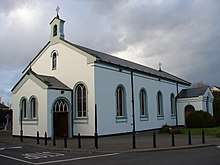
As of the 2016 census, 78.6% of the population of the Douglas electoral division identified as Catholic,[57] with St. Columbas as the first Catholic parish church in the area, dating to 1814.[58] From the 1960s, with housing developments and population growth in Douglas, overcrowding in St. Columbas prompted a decision to build a new Catholic church in the Grange/Frankfield area. This new church (the Church of the Incarnation) was consecrated in 1976, and was a chapel-of-ease to the Douglas parish before being separating into its own parish in 1982.[59] St. Patrick's Catholic church serves the Rochestown area, and dates to 1991.[60]
Other religious congregations serving the Douglas population include St. Lukes (Anglican) church which was consecrated in 1875,[61] the Wesley Chapel (Methodist) church on the Douglas Road,[62] Douglas Baptist congregation (which meets at Douglas Community School),[63] Radical Life (Pentecostal) church,[64][65] the Holy Trinity (Anglican) church in Frankfield which dates to 1838,[66][67] and the Inspiration House (RCCG) in Frankfield.[68]
Notable residents
- John Dunlay, recipient of the Victoria Cross[69]
- Jack Gleeson, film and stage actor[70]
- Gerald Goldberg, first Jewish Lord Mayor of Cork
- Rob Heffernan, Irish Olympian[71]
- Cillian Murphy, film and stage actor[70]
- Billy O'Callaghan, Irish short story writer
- Donncha O'Callaghan, professional Rugby union player
- Ronan O'Gara, professional rugby player
- Lennox Robinson, dramatist, poet and director of the Abbey Theatre[72]
Education
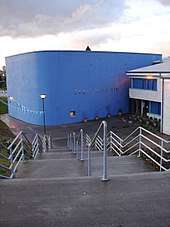
Primary Education:
- Eglantine – Catholic girls school
- Scoil An Athar Tadhg Ó Murchú – Irish language mixed-sex school
- St. Luke's – Church of Ireland mixed-sex school
- Scoil Nioclais – Catholic mixed-sex school
- St. Columba's BNS – Catholic boys school
- St. Columba's GNS – Catholic girls school
Secondary:
- Douglas Community School – boys school
- Regina Mundi College – girls school
Bordering suburbs
See also
Notes and references
- ↑ "Table 205 - Population of towns ordered by county and size" (PDF). Census 2011 - Population Classified by Area. Central Statistics Office (Ireland). Archived from the original (PDF) on 13 November 2012.
- ↑ "Table 206 - Population of each province, county, city, urban area, rural area and electoral division" (PDF). Census 2011 - Population Classified by Area. Central Statistics Office (Ireland). Archived from the original (PDF) on 13 November 2012.
- 1 2 "Cork City boundary extension: Ex-lord mayor in scathing attack on opponents". Irish Examiner. 5 September 2017.
- ↑ "County Hall spends more than €30,000 on legal advice on boundary changes". Evening Echo. 6 June 2018.
- ↑ "Boundary increase for Cork City Council approved by Cabinet". The Irish Times. 6 June 2018.
- ↑ Power, Denis; et al. (1994). Archaeological inventory of County Cork. comprising the Baronies of Barrymore, Cork, Courceys, Imokilly, Kerrycurrihy, Kinalea, Kinnatalloon & Kinsale. Dublin: Stationery Office. pp. 70, 99, 134, 145, 160, 364. ISBN 0707603234.
Nos. 4282,4501,4799,4968,5097 & 6328.
- ↑ Report: Cork Harbour Archaeology. Department of Archaeology, University College Cork. June 1975.
|access-date=requires|url=(help) - ↑ "British Museum - Roman Republican Coins in the British Museum - Castletreasure Farm Hoard". www.britishmuseum.org. Retrieved 4 September 2017.
- ↑ Foley, Con (1991). A History Of Douglas. Cork: R. Lynch. pp. 47–51.
|access-date=requires|url=(help) - ↑ Power, Denis; et al. (1994). Archaeological inventory of County Cork. comprising the Baronies of Barrymore, Cork, Courceys, Imokilly, Kerrycurrihy, Kinalea, Kinnatalloon & Kinsale. Dublin: Stationery Office. p. 210. ISBN 0707603234.
No. 5526.
- ↑ Goddard Henry Orpen (1911). "The Occupation of Cork". Ireland under the Normans. Clarendon Press. p. 47.
- 1 2 3 Foley, Con (1991). A History Of Douglas. Cork: R. Lynch. pp. 3, 5.
|access-date=requires|url=(help) - ↑ Brady, William Maziere (1863). Clerical and Parochial Records of Cork, Cloyne and Ross (PDF). I. p. 60. Retrieved 3 September 2017.
1615... Dowglasse, particula ejusdem, Capella vasta... 1700. Thursday, Sept. 27... Near Douglas, in this parish, is a burying-place, in an open field ; there is still remaining the foundation of a church, but they were carrying away the stones of the foundation. I charg'd them to carry away no more... This was, about 100 years ago, the church of Carickoline parish, before the new church was built, where it now is, in the centre of ye parish.
- 1 2 3 4 5 6 7 8 "History of Douglas". Douglas Community School website. Retrieved 28 August 2017.
- 1 2 3 Foley, Con (1991). A History Of Douglas. Cork: R. Lynch. pp. 12–14.
|access-date=requires|url=(help) - 1 2 3 "Heritage Trail: Douglas Mills - Douglas Tidy Towns". douglastidytowns.ie. Retrieved 3 September 2017.
- ↑ Foley, Con (1991). A History Of Douglas. Cork: R. Lynch. pp. 19–21, 26.
|access-date=requires|url=(help) - 1 2 Foley, Con (1991). A History Of Douglas. Cork: R. Lynch. pp. 31–33.
|access-date=requires|url=(help) - ↑ "Heritage Trail: O'Brien's/St Patrick's Mills - Douglas Tidy Towns". douglastidytowns.ie. Retrieved 4 September 2017.
- ↑ Power, Denis; et al. (1994). Archaeological inventory of County Cork. comprising the Baronies of Barrymore, Cork, Courceys, Imokilly, Kerrycurrihy, Kinalea, Kinnatalloon & Kinsale. Dublin: Stationery Office. p. 357. ISBN 0707603234.
No. 6288.
- ↑ "Donnybrook, County Cork - Terrace of houses most built for mill workers". Buildings of Ireland. National Inventory of Architectural Heritage. Retrieved 3 September 2017.
- ↑ Foley, Con (1991). A History Of Douglas. Cork: R. Lynch. pp. 33–36.
|access-date=requires|url=(help) - ↑ The Parliamentary Gazetteer of Ireland: Adapted to the New Poor-law, Franchise, Municipal and Ecclesiastical Arrangements, and Compiled with a Special Reference to the Lines of Railroad and Canal Communication as Existing in 1843-44. A. Fullarton. 1846. p. 49. Retrieved 4 September 2017.
- 1 2 Foley, Con (1991). A History Of Douglas. Cork: R. Lynch. pp. 52–55.
|access-date=requires|url=(help) - ↑ Power, Denis; et al. (1994). Archaeological inventory of County Cork. comprising the Baronies of Barrymore, Cork, Courceys, Imokilly, Kerrycurrihy, Kinalea, Kinnatalloon & Kinsale. Dublin: Stationery Office. p. 235. ISBN 0707603234.
No. 5594.
- ↑ The Irish Law Times and Solicitors' Journal - Volume 98. J. Falconer. 1965. p. 123.
- 1 2 3 4 Foley, Con (1991). A History Of Douglas. Cork: R. Lynch. pp. 57–59.
|access-date=requires|url=(help) - 1 2 Foley, Con (1991). A History Of Douglas. Cork: R. Lynch. pp. 62–65.
|access-date=requires|url=(help) - ↑ "Douglas Hall, Well Road, Cork, Cork City". Buildings of Ireland. National Inventory of Architectural Heritage. Retrieved 3 September 2017.
- ↑ "Vaucluse House: a brief history". Sydney Living Museums. 2 December 2013. Retrieved 8 September 2017.
- ↑ Foley, Con (1991). A History Of Douglas. Cork: R. Lynch. pp. 104–113.
|access-date=requires|url=(help) - ↑ "Heritage Trail: Tramore House - Douglas Tidy Towns". douglastidytowns.ie. Retrieved 4 September 2017.
- ↑ Foley, Con (1991). A History Of Douglas. Cork: R. Lynch. p. 160.
|access-date=requires|url=(help) - ↑ Foley, Con (1991). A History Of Douglas. Cork: R. Lynch. pp. 39–40.
|access-date=requires|url=(help) - 1 2 Power, Denis; et al. (1994). Archaeological inventory of County Cork. comprising the Baronies of Barrymore, Cork, Courceys, Imokilly, Kerrycurrihy, Kinalea, Kinnatalloon & Kinsale. Dublin: Stationery Office. p. 262. ISBN 0707603234.
No. 5718, 5719.
- ↑ Brady, William Maziere (1863). Clerical and Parochial Records of Cork, Cloyne and Ross (PDF). I. p. 65. Retrieved 3 September 2017.
Douglas Chapel of Ease in good order. Rev. J. Bustead is curate. No glebe-house. Five acres of land set. Divine service twice on all Sundays, and once on usual festivals and fasts. In winter, evening service in a house. 150 children are on rolls of a school kept by local subscribers. The Protestant population of Douglas is 310. Total Protestant population of both parts of this parish is 577.
- 1 2 Foley, Con (1991). A History Of Douglas. Cork: R. Lynch. pp. 42–45.
|access-date=requires|url=(help) - 1 2 "Heritage Trail: St Luke's Church of Ireland - Douglas Tidy Towns". douglastidytowns.ie. Retrieved 3 September 2017.
- ↑ "The clock in St Luke's church - Douglas Tidy Towns". douglastidytowns.ie. Retrieved 3 September 2017.
- ↑ "St. Luke's, Douglas T12 N832". www.douglas.cork.anglican.org. Retrieved 3 September 2017.
- ↑ Power, Denis; et al. (1994). Archaeological inventory of County Cork. comprising the Baronies of Barrymore, Cork, Courceys, Imokilly, Kerrycurrihy, Kinalea, Kinnatalloon & Kinsale. Dublin: Stationery Office. p. 298. ISBN 0707603234.
No. 5899.
- ↑ Foley, Con (1991). A History Of Douglas. Cork: R. Lynch. p. 97.
|access-date=requires|url=(help) - ↑ "Douglas– A short history". Douglas Community Association. Retrieved 23 August 2017.
Douglas underwent significant development from the second half of the 19th century, with the construction of new housing estates
- 1 2 "Frankfield/Grange, Douglas, Cork - Parish History". Frankfieldgrange.ie. Retrieved 28 August 2017.
Major housing development occurred in the Douglas area of Cork from the early 1960s
- ↑ "Lets move to Douglas: Cork suburb with a village feel has something for all". Independent.ie. Independent News & Media. 6 March 2015.
- 1 2 "Ballybrack Woods Trail 2013 Site Assessment Report" (PDF). National Trails Office - Irish Sports Council. 2003. Retrieved 23 August 2017 – via Douglas Tidy Towns.
- ↑ "Credit Union Offices - Contact Details". Douglas Credit Union. Retrieved 21 August 2017.
- ↑ "Mount Oval Pharmacy, The Square, Mount Oval Village" (PDF). Sherry Fitzgerald. Retrieved 23 August 2017.
the commercial centre of Mount Oval Village [..is..] laid out in a courtyard setting with [..a..] dental practice, doctor surgery, Spar, [..and..] bar and restaurant
- ↑ "Douglas Community Park - Management of 5-acre Community Park". Douglas Community Association. Retrieved 7 September 2017.
- ↑ "Vernon Mount Valley & Woodlands Walks Project". Vernon Mount Park. Grange Frankfield Partnership. Retrieved 7 September 2017.
- ↑ Cork City Council (2 July 2012). Tramore Valley Park Masterplan (PDF) (Report). Corkcity.ie. Retrieved 29 July 2014.
- ↑ RPS Group (22 May 2017). "Grange Road to Tramore Valley Park Pedestrian / Cycle Link N40 Overbridge - Preliminary Design Report" (PDF). Cork County Council. Retrieved 4 September 2017.
- 1 2 "Electoral Division Douglas (CSO Area Code ED 18086)". Census 2011 - Small Area Population Statistics. Central Statistics Office (Ireland). Retrieved 28 August 2017.
- ↑ "Douglas Hall A.F.C." Douglashallafc.ie. Retrieved 28 August 2017.
- ↑ "Douglas Golf Club (Maryborough Hill, Douglas, Co. Cork)". Douglasgolf.ie. Retrieved 28 August 2017.
- ↑ "Douglas Rugby Football Club - Club History". DouglasRFC.com. Retrieved 28 August 2017.
Rouglas RFC was initially founded as one of the earliest Cork Rugby clubs in 1902 in the (then) rural village of Douglas, Cork
- ↑ "Census 2016 Sapmap Area: Electoral Division Douglas". SAPMAP. Central Statistics Office. Retrieved 9 September 2017.
- ↑ "Douglas Parish, St St. Columba's Church". Diocese of Cork and Ross. Retrieved 8 September 2017.
- ↑ "Church of the Incarnation, Frankfield/Grange - Parish History". FrankfieldGrange.ie. Retrieved 8 September 2017.
- ↑ "About the Parish". Douglasrochestownparish.ie. Parish of Douglas and Rochestown. Retrieved 9 September 2017.
- ↑ "St. Luke's, Douglas". Douglas Union of Parishes. Retrieved 8 September 2017.
- ↑ "Ardfallen Church". Cork Methodist Church - Wesley Ardfallen. Retrieved 8 September 2017.
- ↑ "Douglas Baptist Church - Meetings". DouglasBaptist.ie. Retrieved 8 September 2017.
- ↑ "Welcome to Radical Life". RadicalLife.ie. Retrieved 7 September 2017.
- ↑ "Pentecost Cork Conference and the Pentecostal & Charismatic Council of Cork - Ireland". Pentecostcork.yolasite.com. Retrieved 7 September 2017.
- ↑ "Holy Trinity, Frankfield". Douglas Union of Parishes. Retrieved 8 September 2017.
- ↑ "Holy Trinity Church of Ireland Church, Frankfield, County Cork". Buildings of Ireland. National Inventory of Architectural Heritage. Retrieved 8 September 2017.
- ↑ "Migrant Churches - Resources - Irish Council of Churches". www.irishchurches.org. Retrieved 8 September 2017.
- ↑ "John Dunlay VC". VCOnline.org.uk. Retrieved 8 September 2017.
- 1 2 "The southside of Cork city spans from the marina to CIT, covering a diverse area geographically, socially and historically". Cork Independent. 22 October 2015. Retrieved 8 September 2017.
Cork's big-screen outputs are from the [Douglas] area, most recently Jack Gleeson [and] Cillian Murphy
- ↑ McHale, John (14 August 2013), "Leeside Legend Rob Gets His Just Reward", Evening Echo, Cork
- ↑ "Lennox Robinson portrait unveiled". Irish Times. 17 January 2014. Retrieved 8 September 2017.
| Wikivoyage has a travel guide for Douglas (Ireland). |